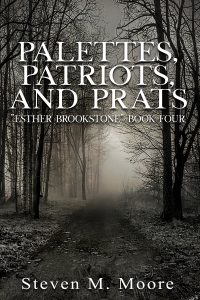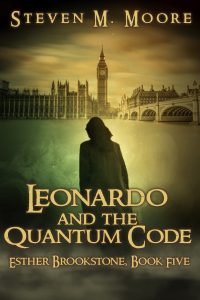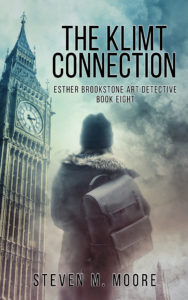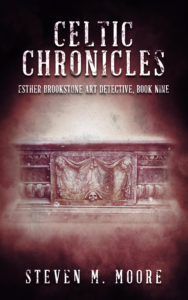Myth vs. reality…
Leonardo da Vinci was a Renaissance man, literally and figuratively. His “Mona Lisa” is the best known painting in the world; his inventions and theories—some valid, some not, but all creations far ahead of his time—have inspired inventors and scientists; and his advances in artistic techniques revolutionized the world of art. Even his notebooks have seduced the likes of Bill Gates.
 Da Vinci is such an important character on the world’s stage that one might wonder why he doesn’t appear in the “Esther Brookstone Art Detective” series. (Nine novels now if you count the two available as free PDF downloads available at this website. I’m currently working on another Brookstone story; it will probably be only a novella.) After all, if I made Leonardo’s appearance more fiction than fact like in Dan Brown’s The Da Vinci Code, I might sell a few more books because people are fascinated with him; but his importance as an artist, self-taught scientist, student of anatomy, and inventor, whether in myth or reality, would always dominate my novel.
Da Vinci is such an important character on the world’s stage that one might wonder why he doesn’t appear in the “Esther Brookstone Art Detective” series. (Nine novels now if you count the two available as free PDF downloads available at this website. I’m currently working on another Brookstone story; it will probably be only a novella.) After all, if I made Leonardo’s appearance more fiction than fact like in Dan Brown’s The Da Vinci Code, I might sell a few more books because people are fascinated with him; but his importance as an artist, self-taught scientist, student of anatomy, and inventor, whether in myth or reality, would always dominate my novel.
 I came close, though. Son of Thunder featured Sandro Botticelli, a competitor of Da Vinci. (They might be called bitter enemies!) Between Esther, Botticelli, and St. John, Sandro Botticelli is the least important character in this mystery/thriller novel that’s also historical fiction. Leonardo would have stolen the show, I’m sure. In Leonardo and the Quantum Code, one of Da Vinci’s notebooks plays an important role, not Leonardo per se. (And that’s more as an inventor of some techniques that motivate a physicist to create new encryption algorithms for quantum computers. By the way, I don’t believe true AI can exist without quantum computers!)
I came close, though. Son of Thunder featured Sandro Botticelli, a competitor of Da Vinci. (They might be called bitter enemies!) Between Esther, Botticelli, and St. John, Sandro Botticelli is the least important character in this mystery/thriller novel that’s also historical fiction. Leonardo would have stolen the show, I’m sure. In Leonardo and the Quantum Code, one of Da Vinci’s notebooks plays an important role, not Leonardo per se. (And that’s more as an inventor of some techniques that motivate a physicist to create new encryption algorithms for quantum computers. By the way, I don’t believe true AI can exist without quantum computers!)
 In the first novel mentioned, Leonardo only appears as Sandro’s competitor; in the second, he only appears as the author of that notebook that British, Russian, and US agents are after. (I assumed that the one Bill Gates has doesn’t contain what leads to that quantum code!)
In the first novel mentioned, Leonardo only appears as Sandro’s competitor; in the second, he only appears as the author of that notebook that British, Russian, and US agents are after. (I assumed that the one Bill Gates has doesn’t contain what leads to that quantum code!)
Recently, someone studied the background in the “Mona Lisa” and concluded it showed a landscape near Lecco, Italy; other historians have wasted a lot of time trying to decide who “Mona” was as well. (The model for Venus in Botticelli’s “Birth of Venus” has received similar attention but not as much; in Son of Thunder, she’s Vespucci’s daughter, one theory being that she and Sandro were lovers.) The “Mona Lisa” has been attacked by eco-terrorists and other crazies. (Botticelli fans? People who are fans of “The Scream”?). But oddly enough, Da Vinci’s “The Last Supper,” not the “Mona Lisa,” is featured by Dan Brown in The Da Vinci Code because Christ (and his descendants!) plays such an important role in that novel so filled with historical errors it should be called a fantasy. (Christ also indirectly plays an important role in Son of Thunder, of course, which I consider The Da Vinci Code done right. In my novel, the Magdalene is just another but very important organizer of the Christian revolutionary cabal setting out to reform the ancient world; St. John is another.)
 Esther Brookstone’s preferences in art lean toward painters from the Renaissance and earlier; so she might have preferred featuring Leonardo’s art, not Botticelli’s or Da Vinci’s notebook. I didn’t give into her preferences, though. The Brazilian artist Ricardo Silva is now featured in her gallery because his wild abstracts sell well. And she’s also added three Chinese immigrant artists’ impressionist landscapes as well. (Perhaps more to badger the Chinese government who forced them to flee Hong Kong? Or as complements to the mystic landscapes of Silva’s wife Bobbie?). Esther insisted on returning a stolen Klimt painting to its rightful owner in The Klimt Connection; that Austrian painter is another modernist. In other words, I chose to expand the old girl’s artistic horizons! And, considering the price of most any painting by Da Vinci, one can bet a Da Vinci won’t be on sell anytime soon at her gallery! She’ll just have to continue featuring paintings of saints with halos, perhaps of comparable quality relative to any Da Vinci painting but now mostly forgotten by art history.
Esther Brookstone’s preferences in art lean toward painters from the Renaissance and earlier; so she might have preferred featuring Leonardo’s art, not Botticelli’s or Da Vinci’s notebook. I didn’t give into her preferences, though. The Brazilian artist Ricardo Silva is now featured in her gallery because his wild abstracts sell well. And she’s also added three Chinese immigrant artists’ impressionist landscapes as well. (Perhaps more to badger the Chinese government who forced them to flee Hong Kong? Or as complements to the mystic landscapes of Silva’s wife Bobbie?). Esther insisted on returning a stolen Klimt painting to its rightful owner in The Klimt Connection; that Austrian painter is another modernist. In other words, I chose to expand the old girl’s artistic horizons! And, considering the price of most any painting by Da Vinci, one can bet a Da Vinci won’t be on sell anytime soon at her gallery! She’ll just have to continue featuring paintings of saints with halos, perhaps of comparable quality relative to any Da Vinci painting but now mostly forgotten by art history.
***
 Comments are always welcome. (Please follow the rules on the “Join the Conversation” webpage.)
Comments are always welcome. (Please follow the rules on the “Join the Conversation” webpage.)
“Esther Brookstone Art Detective.” The nine novels in this series are as much about Esther, a sexier and more agile Miss Marple, and her paramour and later husband, Bastiann van Coevorden, who looks like the actor who played Hercule Poirot, as they fight the good fight against diabolical spies, terrorists, and other villains. They’re also more about travel in and around the UK, Europe, and overseas as they’re about art thieves, art forgers, and trafficking of stolen artwork. Two novels are free, appearing in the list of free PDF downloads found on the “Free Stuff & Contests” webpage (the new Esther Brookstone novella will also be available there). The others are inexpensive ebooks, and the first three also are available in paper format. Enjoy!
Around the world and to the stars! In libris libertas!
